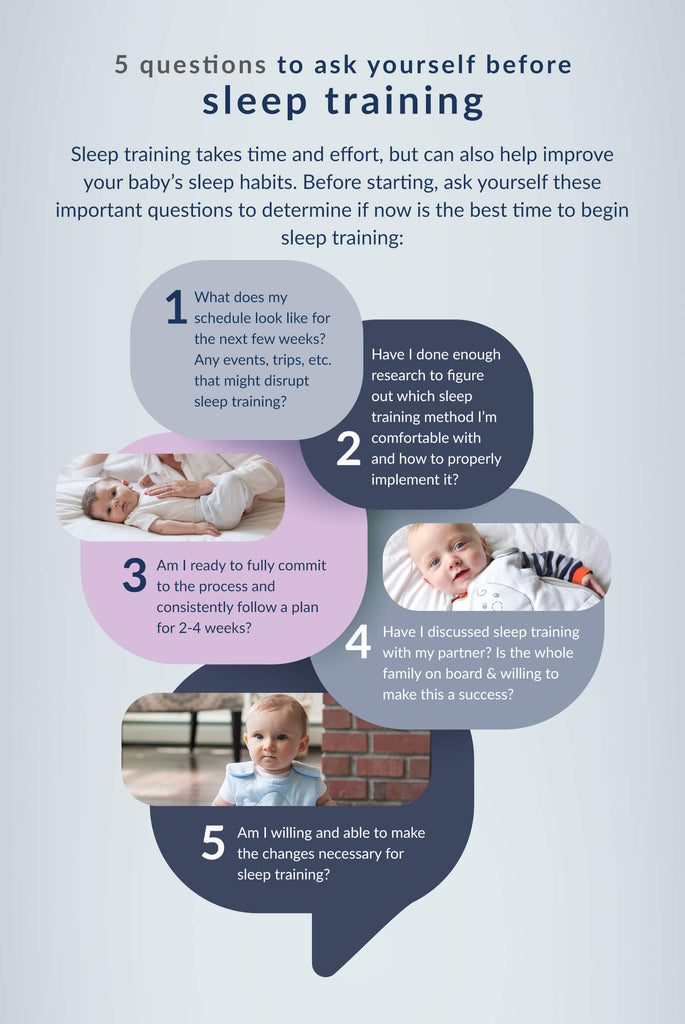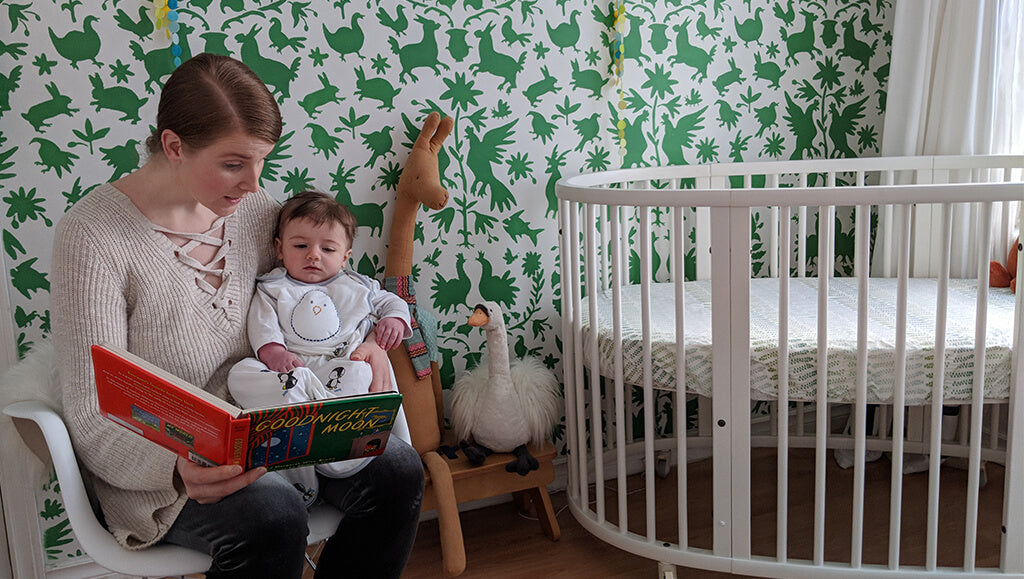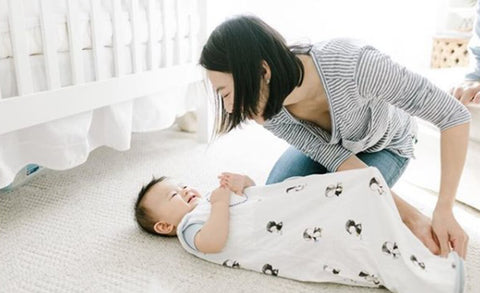Shopping Cart
Looking for advice on sleep training newborn babies? You’ve probably come to the experts at Nested Bean for tips on how to sleep train baby because you’re exhausted from the constant struggle to get your child to sleep. It’s not just leaving you tired each day, but affecting your health more than you may realize.
The good news is that helping your baby learn how to fall asleep and stay asleep independently is simpler than you may have initially thought.
There’s a lot of information on sleep training infants out there, leaving most parents confused, frustrated, and still wondering what sleep training is and how to do it. In this article, we’ve rounded up all the facts from real moms and professional sleep consultants on what sleep training is, how to do it, and how to decide if it’s right for you.
First, let us introduce you to Melissa, mom of 6-month-old Theo. After struggling with sleep training, Melissa offered to share her personal story and best sleep training tips for other moms thinking of giving it a try.
Since it's always most helpful to hear from a mom who's been there, throughout our Sleep Training Guide Melissa will be sharing what worked for her and her son during sleep training. But first, what is sleep training baby all about?
What is sleep training for newborns?
It might be strange to think of sleeping as a skill that does not come naturally. As a new parent, you’re probably so exhausted that you pass out as soon as your head hits the pillow.
Your baby, however, doesn’t have this same ability yet. Although they spend a lot of time sleeping, they need to learn when to sleep (day vs. night) and how to sleep.
Until they do, they need your assistance, which is why you (as you should) help soothe them to sleep at bedtime and comfort them when they wake in the middle of the night.
Sleep training is teaching your baby how to sleep without any help from you - just like you’re able to go to sleep without anyone there to help you do it.
FROM THE EXPERTS“Everybody with a baby has been sleep training since the minute the baby arrived on the scene. Learning to sleep is a skill that we teach with swaddles, pacifiers, swings, nursing, white noise, consistency, and bedtime routines. All of these, collectively, constitute sleep training." - Alexis, Precious Little Sleep |
If you search “what is sleep training?” you’ll find the following definition:
“The process of training young children to fall asleep on their own, typically by means of techniques in which the child is left to cry without being comforted, either for gradually increasing periods of time or until they fall asleep.”
It’s definitions like this that have given the general term “sleep training” a bit of a bad rep. There are certain methods of sleep training, such as “Cry-It-Out” or the Ferber method, that might make some parents wearisome of sleep training as a whole. However, sleep training does not necessarily equal cry it out. There are many different sleep training methods and practices behind sleep training, including gentle sleep training methods —the most important part of sleep training is finding the method that works best for you and your baby!
Sleep training looks different for every family based on their needs and what they are comfortable with. So before we go any further, let’s establish what sleep training babies is NOT:
- Sleep training is NOT "Cry It Out" (CIO) if you don't want it to be
- Sleep training is NOT neglecting your baby
- Sleep training is NOT denying your baby food when they are hungry at night
- Sleep training is NOT about getting your baby on the schedule that’s best for you
Alternatively, look at the term sleep training like this: sleep training is giving my baby the tools and skills they need to help them sleep better on their own in a way that me and my family are comfortable with. With that being said, let’s talk about when to start sleep training baby.
When to start sleep training baby?
So, when can you start sleep training newborn babies? It's almost a trick question. There's no one "sleep training age" — the answer will be different for every baby! Plus, there’s a different question you should be asking first: How do I know if I’m ready for sleep training?
That’s right! Your baby of course needs to be ready - but before they are, YOU need to be ready too. Sleep training requires a commitment from parents.
You’ll also want to be sure you’re logistically ready to begin sleep training, as it’s best to start when you don’t have anything that might disrupt the training coming in the near future, such as a vacation or trip.
QUESTIONS TO ASK YOURSELF BEFORE STARTING SLEEP TRAINING:1. What does my schedule look like for the next few weeks? Any events, trips, etc. that might disrupt sleep training? 2. Have I done enough research to figure out which sleep training method I’m comfortable with and how to properly implement it? 3. Am I ready to fully commit to the process and consistently follow a plan for 2-4 weeks? 4. Have I discussed sleep training with my partner? Is the whole family on board and willing to make this a success? 5. Am I willing and able to make the changes necessary for sleep training? |
Answering these questions will require that you do your research and communicate with your partner or anyone living in your home. We’ll talk more about how to prepare for sleep training later on. But keep these questions in mind while you begin your research on sleep training.

Once you’ve decided that you’re ready for sleep training, you’ll need to determine if your baby is ready too. First, get clearance from their pediatrician to rule out any other health or medical factors that could be playing a role in your child’s sleep.
FROM THE EXPERTS“I always say bedtime and nap routines can start from day 1. A child is never too young to learn healthy sleep habits and routines! But to get a baby sleeping through the night there are a few things I check. The baby should be at least 15 lbs, no medical concerns, and on a healthy growth curve approved by their pediatrician. If all these points are met, then I'm ready to start getting that little one sleeping through the night!" - Rachel Turner, Hello Sleep |
Consider your child’s age
Next, consider their age. Most babies are not ready for “formal” sleep training until 4 months old to 5 months old. However, setting up healthy sleeping habits can start from birth. Establishing bedtime routines, putting your baby down drowsy but awake, and other techniques can lay the foundation for sleep training.
The first time around, Melissa didn’t have much success sleep training Theo - he just wasn’t ready yet! Here’s how she knew when it was time to try again:
With age, the baby REM sleep cycle will start to change (which is the main reason behind the 4 month sleep regression, the 6 month sleep regression, the 8 month sleep regression, and even the 4 year old sleep regression) often sending parents searching for sleep training solutions. Before this point, your goal should be to teach them good sleep habits.
AGES & STAGES OF SLEEP TRAINING
|
0-6 Weeks |
SLEEP SURVIVING |
As a newborn, the most important thing is getting enough sleep. No need to stress over schedules, routines, or training here. |
|
2-3 Months |
SLEEP LEARNING |
Although it's still a bit early for formal training, your baby is old enough to start learning routines and schedules. Start incorporating a set bedtime routine and healthy sleep habits. |
|
4-6 Months |
SLEEP TRAINING |
Now you can introduce some "formal" sleep training. Your baby's sleep cycle changes around this age, which means they can start to learn how to fall asleep and self-soothe.. |
Is it ever too late to sleep train?
If your baby is past the 6-month mark, you might be asking “is it too late to sleep train my child?” Many parents wait to begin sleep training hoping that their child will just grow out of being a “bad” sleeper. Luckily, sleep training has no expiration date and can be done with babies at any age - even into toddlerhood!
How do I know if my baby needs newborn sleep training?
Parents often wonder how to know if your child needs sleep training or if their sleep habits are just something they’ll grow out of. If your baby is consistently cranky and overtired, it's probably time to look into helping them become a better sleeper.
And as Melissa noted, she started sleep training the second time around because she could tell her son was just as frustrated as she was about not getting a good night's sleep!

Healthy sleep is so important for your baby AND you! If your baby isn’t sleeping, chances are you aren’t either. Sleep deprivation in children has been linked to obesity, behavioral problems, learning issues, and more later on in life. Teaching and establishing healthy sleep habits right from the start will make sleep training easier and, more importantly, help keep you and your baby well-rested!
Healthy sleep is so important for your baby AND you! If your baby isn’t sleeping, chances are you aren’t either. Sleep deprivation in children has been linked to obesity, behavioral problems, learning issues, and more later on in life. Teaching and establishing healthy sleep habits right from the start will make sleep training easier and, more importantly, help keep you and your baby well-rested!
How do I prepare for sleep training baby?
There are a number of ways you can prepare yourself and your baby for sleep training, but the most important step in your preparation is: research.
Do your research! There is a lot of information about there about infant sleep training, and much of it is controversial or contradicting. However, just like making any important decision, your choice to train (or to not) should be informed by your own reading, research, and inferences. Furthermore, there are many different methods of sleep training (which we’ll cover in this article as well) and you’ll need to decide which sleep training technique is right for you.
As we previously mentioned, introducing healthy sleep habits and routines as early as possible will help significantly during sleep training. If you haven’t already, try to establish a bedtime routine before you start to train baby — this will encourage healthy baby sleep patterns. This should be a series of soothing activities that help to calm your baby and prepare them for sleep - you can reap the benefits of swaddling, bathing, and rocking, but every family’s routine will look different.
You can also incorporate the Zen Sack into your baby’s bedtime routine. The gently weighted center of the Zen Sack helps to calm babies and aids in teaching them to self soothe, which is what sleep training is all about! The gently weighted center actually mimics your touch offering comfort and security to your baby, even when you’re not there. The extra bit of pressure from the Zen Sack has been shown to help babies feel calm and fall back to sleep easier...super helpful for starting sleep training!
|
The Zen Sack can help your baby learn to self soothe while sleep training! |
Lastly, make sure you have discussed sleep training thoroughly with your partner and clear your schedule for the next 2 to 4 weeks. Sleep training takes time, patience, and consistency. You’ll want to be sure nothing is going to disturb your sleep training schedule and that you and your partner are fully devoted to sticking with the plan!
How to sleep train: The various newborn sleep training methods you can try
Ready to learn how to sleep training? By the time you finish reading this guide, you’ll feel confident in your next steps to sleep training baby. But before we can actually talk about how to sleep train, we must discuss the various sleep training methods.
The importance of picking the right sleep training method
One of the most important aspects of infant sleep training is finding the sleep training method that works best for you. Ultimately, YOU are the only one who knows what your (and your baby’s) tolerance for crying is. If a method doesn’t feel right or sounds too “intense” for you, then don’t try it. Start with a gentle plan that you’re comfortable with.
Keep in mind that you and your partner might have different comfort levels and tolerances. Make sure to discuss the approach you want to take and incorporate sleep training into a consistent bedtime routine you set up together. It’s best to start small and, if needed, move to a less gentle method so you can learn what you’re comfortable with and what just isn’t going to work for you and your family.
Ultimately, the best method for you and your family is going to be the one that you can alter to meet your needs and comfort levels. Melissa points out that although she chose a particular sleep training program, she made it work for her.
There are many different sleep training methods to choose from, but the most common sleep training techniques are one of or a variation of one of the five we've explained below.
You might find that one of these methods sounds like it would be a perfect match for you, OR you might find aspects from each plan that you like. Just like Melissa said, don't feel like you need to stick to a certain method 100%. Make the plan work for you!
The Pick-Up-Put-Down method
The basic idea around the pick-up, put-down sleep training method is self-explanatory by the name. This gentler sleep training technique involves putting your baby in their crib and if they wake up and are fussing, take them out of the crib and hold them for a bit to calm them down and then put them back into the crib.
These steps are repeated as needed until baby falls asleep. This method is believed to help babies learn to self-soothe but allows the parent to take an active role rather than letting baby cry in their crib alone. Before you know it, your baby fighting sleep will be a distant memory of the past!
The Camping Out (aka Chair) method
Camping Out sleep training, or the Chair Method, is staying in baby’s room with them in order to help your baby settle. You can sit in a chair or place a bed or mattress to lie next to your baby while you pat or stroke baby into sleep. Then your gradually reduce the amount of time you spend settling baby with touch.
Eventually, you start to move your chair or mattress away from the crib and out of your baby’s room. According to Sleep.org, “Some parents find it easier not to leave their baby alone while they cry.
However, if you're still in the room when your baby falls asleep, they might be distressed when they wake up in the middle of the night and you are no longer there.”
The Fading method
Bedtime fading method, or Fading Method of sleep training, is based around sleep patterns and cues your baby displays when they are ready to sleep. Parents must pay attention to their baby’s sleep cues to know when they are ready for sleep and use those as indicators for when to put them down.
Once a specific bedtime is established you can start to shift bedtime to earlier or later depending on the schedule you want to keep. Those shifts should be gradual until you reach your desired bedtime. From Sleep.org, “Once your baby is falling asleep more quickly, you can move bedtime earlier by 15 to 30 minutes. This process can be repeated until a baby's bedtime is where you want it.”
The Ferber method (aka Ferberization or Graduated Extinction)
Feber method is a type of “graduated extinction” and was designed to help babies learn to self-soothe and to fall asleep independently or back to sleep if they wake up in the middle of the night.
This method is on the less gentle side of the scale since it involves letting your baby cry, but only for a specific amount of time before you go and check on them.
Sleep.org says; “Using graduated extinction, parents gradually increase the time before checking on their baby after the baby begins crying, by first waiting two minutes, then five minutes, then ten, and so on. Checks should last less than a minute, and you should try to avoid picking your baby up.”
The Cry-It-Out method (aka Extinction)
The Cry-it-out Method or Extinction falls as the least gentle sleep training method on the scale. It can be difficult for parents to let their baby continue to cry in order to learn to self-soothe.
Essentially, your baby is put to bed when they are drowsy, but still awake so they can learn to start falling asleep independently as well as begin the process of self-soothing if they begin to wake up.
From there, parents should leave the baby until the next morning allowing them to “cry it out” if they wake. Sleep.org states, “Parents using the extinction method usually see improvements to their baby's sleep after just a few days. However, the extinction method has faced controversy because many parents find it difficult to ignore their baby's crying.”
You may have also heard of the "sleep sense" (Melissa mentions in the video above) or the "sleep lady shuffle." These are simply different sleep training programs, as opposed to a single method. However, they usually incorporate or work from the same methods we covered above.

While researching the different sleep training methods to decide which one is right for you, also remember that every baby and every family is different. What one mom swears by, another mom swears off. You will see the most success from sleep training if you use your intuition to pick a method that you know you and your baby will be comfortable with.
How can I ensure success when sleep training newborn babies?
Infant sleep training will look a little bit different for every family, depending on what method you choose to follow. The different methods require different tactics from the parents in order to be successful. Pro tip: take notes! Having a record of how your baby has progressed throughout the sleep training will come in handy when you’re too tired to remember how long (or little) they slept the previous night.
Should I hire a sleep coach or sleep consultant to help with sleep training?
Some families opt to hire a sleep consultant or sleep coach to help them with infant sleep training. Just like deciding what sleep training method is best for your family, the decision to hire a sleep coach is a completely personal one.
We talked to Rachel Turner, a certified sleep consultant and owner of Hello Sleep, and asked her how why a family might consider hiring a sleep consultant. Here's what she had to say:
"With all of the information that’s readily available online and all the books and resources at your disposal in the form of friends and family who have managed to get their kids to sleep, why would you want to invite a stranger into your home to get your child sleeping through the night?

I know a lot of my clients felt that way before they hired me! But I know it’s a concern that a lot of parents have when they’re thinking about getting some professional help with their little ones’ sleep habits. And it’s a valid question! After all, your mother managed to get you to sleep at some point. Your friend might have four kids who are all champion sleepers, so she should have some answers for you, right? Well, yes.. .and no!
The biggest reason why the solutions that work for one parent don’t work for another is simple. They’re not dealing with the same baby. Some babies are heavily reliant on sleep props. Others can’t sleep in a room that’s too warm. Some may not be getting enough daytime sleep, and others might be overtired.
This baby might have developed an association between feeding and falling asleep, whereas that one might be ready to drop their second daytime nap. And, of course, it could be any combination of all of the above, or the many other sleep challenges that babies might experience.
Adding to the challenge is the fact that most solutions don’t work overnight, so parents might try a solution that could potentially help baby start sleeping through the night, but abandon it before it takes effect due to some heavy protesting on baby’s part.
FROM THE EXPERTS“The biggest reason why the solutions that work for one parent don’t work for another is simple. They’re not dealing with the same baby...sleep is a complicated issue and there’s very rarely one single thing that can remedy the situation overnight. A professional sleep consultant has the experience and training to recognize which problems result in specific symptoms, and can work with you to develop a personalized plan for your child that addresses those individual issues." - Rachel Turner, Hello Sleep |
In short, sleep is a complicated issue and there’s very rarely one single thing that can remedy the situation overnight. A professional sleep consultant has the experience and training to recognize which problems result in specific symptoms, and can work with you to develop a personalized plan for your child that addresses those individual issues.
They can also provide some much-needed support when things don’t seem to be working, and give you the encouragement you need to follow through on that plan until it starts to work.”
Want to hear more about what it’s like to work with a sleep consultant during sleep training? Check out our Sleep Training Q&A with Taking Cara Babies.
The Zen Swaddle and Zen Sack are used by many sleep consultants as a tool to help babies sleep better on their own. Parents who use the Zen Swaddle or Zen Sack have seen great results when incorporating it into their sleep training efforts!
We’ll talk more about the best transitional swaddle shortly, along with why you should swaddle a baby in the first place. We also have tips on choosing between a sleep sack vs swaddle, how to use swaddles, the benefits of sleep sacks, and when to stop using a sleep sack.
 |
Real Mom Review“I used his Zen swaddle religiously until he out grew and it helped so much with sleep training! Last night he slept 11 1/2 hours straight without even waking for a bottle. I am convinced his awesome night-time sleeping habits are because of his early on swaddling...I am so thankful for his Zen Swaddle!" -Reeba S. 11/8/2017 |
READ MORE MOM SUCCESS STORIES HERE |
Lastly, remember that sleep training takes loads of patience. Here's Melissa's parting words of advice:
The Role of Feeding in Sleep Training
Understanding the link between feedings and your child’s sleep habits is critical when sleep training baby. An inconsistent feeding schedule can easily lead to erratic sleep patterns, and vice versa. It's essential to recognize how these two routines coexist to make your sleep training as effective as possible.
Breastfed vs. Formula-fed Babies
Breastfed babies may require more frequent feedings than formula-fed babies, particularly in the early months. This can have implications for sleep training schedules. Formula tends to be digested more slowly, often allowing formula-fed babies to sleep for longer stretches earlier on. But regardless of the feeding method, a well-fed baby is generally a more content, better-sleeping baby.
Feeding Before Sleep: Yay or Nay?
While it might seem intuitive to feed your baby to drowsiness, experts warn against making this a habit. Doing so can create a dependency where the baby associates sleep solely with feeding. Instead, try to separate feeding from the sleep routine by at least 20-30 minutes when possible.
Night Feeding and Sleep Training
Night feeds are generally essential for younger babies but can be gradually phased out as your baby grows and starts eating more solid food. Look for signs that your child is ready to drop a night feeding, such as not feeding as much during nighttime or going back to sleep without a feed.
Sleep Training Twins or Multiple Babies
Dealing with one newborn not sleeping is bad enough - but what if you’re trying to get more than one to sleep? Sleep training twins or multiple babies is entirely possible - and it can be double the fun!
However, while it may be tempting to sync up your twins or multiples completely, remember that each child is an individual with unique needs. Initial attempts to create a simultaneous sleep schedule may backfire, causing more disruptions.
And you can consider a tag-team approach with your partner to ensure each of you gets some rest. One parent can handle the first part of the night, and the other can take over for the second half.
The Psychological Aspect for Parents
Newborn sleep training is not just challenging for babies - it can also be emotionally draining for parents. Hearing your baby cry and exercising restraint from rushing in can lead to feelings of guilt and worry. But, it’s absolutely critical - as you know now after reading this guide on how to sleep train.
As you journey forward, it's vital to have a support network in place. This could be your partner, a friend, or a sleep training consultant. Make sure to also schedule some time for self-care to manage stress. Mindfulness and meditation techniques can sometimes help ease the emotional burden.
What To Do After Successful Sleep Training Baby?
Picture this - you have followed our tips on how to sleep train and your newborn baby is now sleeping perfectly. What do you do now besides celebrate success? The key is consistency. Stick to your routine as much as possible to reinforce the healthy sleep habits you've established.
After sleep training newborn babies, the next significant milestone could be transitioning your child from a crib to a toddler bed. Make sure to make this transition as smooth as possible by preparing your child emotionally and sticking to the routine you've established.
As your child grows, new sleep disruptors like teething, illness, or travel will inevitably arise. The resilience of your sleep training will be tested. Always be prepared to adapt and, if necessary, reinforce newborn sleep training during these times.
Common questions about newborn sleep training
Hopefully, this guide on how to sleep train provides you with the confidence that you can get your child’s sleep schedule on track. But, before we bring this guide on newborn sleep training to a close, here are some of the most common questions we see circulating on the topic.
How do you sleep train a 1-year-old?
Studies indicate that as many as 20 percent of children between the ages of 1 and 3 still continue to wake up regularly in the middle of the night, But experts agree: it’s never too late to learn good sleep habits. The goal with sleep training, at any age, is for the child to fall asleep on their own.
With toddlers, parents have to focus on consistency and setting limits. Experts recommend the ‘pick up/put down’ method or the ‘Ferber’ method for toddlers. To ensure success, make sure your toddler is getting 1 or 2 naps each day, has a bedtime of about 7 pm and has a bedtime routine no longer than about 30 minutes. .
Can you sleep train a 3-month-old?
Between the 3- and 4-month mark, babies can start sleep training. By 3 months, a baby’s stomach has grown, which means they can stay seated for longer periods, and sleep longer as a result By 4 months, babies can likely go 8 to 12 hours without needing a feeding at night.
Is sleep training safe for babies?
Yes, sleep training newborn babies is generally considered safe. However, it's crucial to consult your pediatrician before beginning any sleep training regimen to ensure it aligns with your child's age, weight, and overall health.
Different sleep training methods may suit different children, but a healthcare professional can provide tailored advice. Moreover, sleep training baby is not just about teaching your baby to sleep independently; it also encompasses creating a safe, consistent, and nurturing sleep environment for them.
Always prioritize safety by following guidelines for safe sleep spaces, such as placing the baby on their back to sleep, avoiding soft bedding, and making sure there are no loose objects in the crib.
Is sleep training just letting baby cry?
No, sleep training doesn't have to involve letting your baby cry uncontrollably. While the "Cry It Out" (CIO) method is one well-known approach, there are multiple other methods like the "No Tears" approach, the "Fading Method," or "Chair Method" that involve less crying.
Each of these sleep training methods has its own philosophy on how to minimize fussiness and help your baby learn to self-soothe. Parents can choose a technique that aligns with their comfort level and their baby's temperament.
It's important to remember that some amount of fussiness is to be expected during the transition, but it shouldn't result in prolonged distress for either you or your baby.
What is the most effective way to sleep train?
The effectiveness of sleep training baby is subjective and often varies from child to child. However, consistent routine and timing are key elements that make any sleep training method more effective. Here are some general guidelines:
- Age Appropriate: It's advisable to start sleep training when your baby is developmentally ready, typically around 4-6 months. Some methods may be more suitable for younger infants while others are better for older babies.
- Consistency is Key: Regardless of which method you choose, being consistent in your approach will make the transition easier for your baby to understand and adapt to.
- Customizable: A one-size-fits-all approach may not work for every baby. Be prepared to adjust your strategy based on your baby's unique needs and responses.
It's advisable to consult a healthcare professional to determine what may be the most suitable method for your child. And with all that said, it’s time we brought this guide on when to start sleep training newborn babies to a close.
Final Thoughts on When to Start Sleep Training Baby (and How to Sleep Train Newborns)
We hope this guide on sleep training baby helps you feel more in control of your life, as a sleepless newborn can take a dramatic toll on your day-to-day. You’ve learned when to start sleep training newborns, and we’ve also covered how to sleep train babies using the most common sleep training methods.
At this point, all that’s left to do is sit down and think about what makes the most sense for you and your child. Remember, it’s never too late to start sleep training - so don’t be discouraged if you feel behind the 8-ball.
If you’d like to learn more about sleep, our blog has a wealth of resources on topics like how to get newborn to sleep at night, when do toddlers stop napping, home remedies for teething baby at night, baby separation anxiety, newborn won't sleep unless held, signs of sleep regression, and more.
Or, set yourself up for a blissful night of sleep with the right sleepwear for your child. As we mentioned throughout this guide to sleep training newborn babies, Nested Bean has an amazing selection of weighted sleepwear that ranges from weighted swaddles to weighted sleep sacks.
Explore our zipper swaddle, transitional swaddle, bamboo sleep sack, winter sleep sack, bamboo swaddle, and all the other types of swaddles for newborns we have to help you finally achieve a good night’s sleep. Otherwise, it’s time to put these sleep training methods to the test and make frustrating, sleepless nights a problem of the past!


